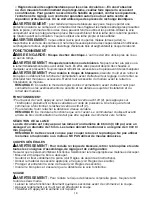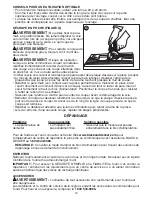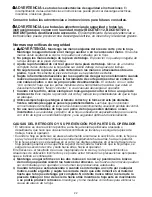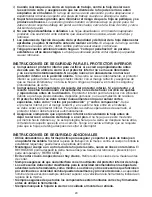
8
OPERATION
• To switch the tool on, press and hold the active lock-off button (2), then fully press the variable speed
switch on the power unit. Once the bit begins to operate, release the active lock-off button (2).
• To switch the tool off, release the variable speed switch.
NOTE:
This tool attachment only operates in the forward direction; the forward/reverse slider
of the Power Unit should not be able to be switch to reverse.
BLADE SELECTION
Your circular saw is designed for use with 3-3/8 inch (86 mm) diameter blades that have a
15 mm diameter bore. Blades must be rated for 3000 RPM operation (or higher).
NOTE:
This saw is designed to cut wood and plastic. Do not use masonry or metal
cutting blades. DO NOT use any abrasive wheels.
GENERAL CUTS
WARNING
: To reduce the risk of injury, remove the battery, and follow all assembly,
adjustment and set up instructions.
Make sure lower guard operates. Select the proper blade for the material to be cut.
• Measure and mark work for cutting.
• Support and secure work properly (See Safety Rules and Instructions).
• Use appropriate and required safety equipment (See Safety Rules).
• Secure and maintain work area (See Safety Rules).
• With battery inserted, make sure switch turns saw on and off.
SAWING
WARNING
:
To reduce the risk of serious personal injury, always hold the tool with both
hands as illustrated in
Figure G
below.
• Let the blade run freely for a few seconds before starting the cut.
• Apply only a gentle pressure to the tool while performing the cut.
• Work with the shoe (5) pressed against the workpiece.
HINTS FOR OPTIMUM USE
• For best results use a blade with 20-24 cutting teeth.
• As some splintering along the line of cut on the top side of the workpiece cannot be avoided,
cut on the side where splintering is acceptable.
• Where splintering is to be minimized, e.g. when cutting laminates, clamp a piece of plywood
onto the top of the workpiece.
POCKET CUTTING (FIGURE G)
WARNING
:
Never tie the blade guard in a raised
position. Never move the saw backwards when
pocket cutting. This may cause the unit to raise up off
the work surface which could cause injury.
WARNING
:
To reduce the risk of serious personal
injury, always hold the tool with both hands.
WARNING
: Laceration Hazard.
As blade starts
cutting the material, release the retracting lever
immediately.
A pocket cut is one that is made in a floor, wall, or
other flat surface.
• Tilt the saw forward and rest front of the shoe on
material to be cut.
• Using the retracting lever (8), retract lower blade guard (7) to an upward position. Lower rear of
shoe until blade teeth almost touch cutting line.
• Release the blade guard (its contact with the work will keep it in position to open freely as you
start the cut). Remove hand from retracting lever and firmly grip the top of the power unit, as
shown in
Figure G
. Position your body and arm to allow you to resist kickback if it occurs.
• Make sure blade is not in contact with cutting surface before starting saw.
G









































